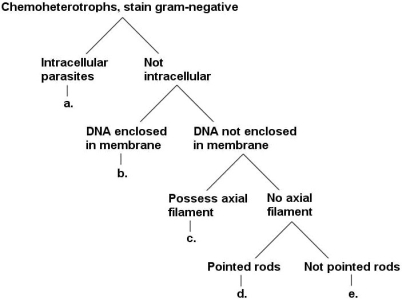A) Gardnerella
B) Listeria
C) Corynebacterium
D) Actinomyces
E) Mycobacterium
G) B) and C)
Correct Answer

verified
Correct Answer
verified
Multiple Choice
Actinomycetes differ from fungi in that actinomycetes
A) lack a membrane-bounded nucleus.
B) are chemoheterotrophs.
C) cause disease.
D) are decomposers.
E) require light.
G) A) and C)
Correct Answer

verified
Correct Answer
verified
Multiple Choice
Thiobacillus oxidizes inorganic sulfur compounds and reduces Co2. This bacterium is a
A) chemoheterotroph.
B) chemoautotroph.
C) gammaproteobacteria.
D) photoheterotroph.
E) photoautotroph.
G) None of the above
Correct Answer

verified
Correct Answer
verified
Multiple Choice
Borrelia is classified as a spirochete because it
A) is transmitted by ticks.
B) possesses an axial filament.
C) is a rod.
D) is a pathogen.
E) is aerobic.
G) All of the above
Correct Answer

verified
Correct Answer
verified
True/False
Currently, no members of Archaea have been linked to human disease.
B) False
Correct Answer

verified
Correct Answer
verified
Essay
A colleague proposes that the Archaea may be the oldest life forms currently inhabiting Earth. Do you agree? Explain.
Correct Answer

Answered by ExamLex AI
While it is a widely accepted hypothesis...View Answer
Show Answer
Correct Answer
Answered by ExamLex AI
View Answer
Essay
The use of culture-independent techniques has increased our understanding of microbial diversity without cultivation. Therefore, do microbiologists still need to attempt to grow new microbial species? Explain.
Correct Answer

Answered by ExamLex AI
Yes, microbiologists still need to attem...View Answer
Show Answer
Correct Answer
Answered by ExamLex AI
View Answer
Multiple Choice
Which one of the following does NOT belong with the others?
A) Staphylococcus
B) Rickettsia
C) Wolbachia
D) Coxiella
E) Ehrlichia
G) B) and C)
Correct Answer

verified
Correct Answer
verified
Multiple Choice
Burkholderia was reclassified from the gammaproteobacteria to the betaproteobacteria because
A) it causes infections in cystic fibrosis patients.
B) it is a gram-negative rod.
C) its rRNA sequence is similar to that of Neisseria.
D) it causes melioidosis.
E) it grows in disinfectants.
G) D) and E)
Correct Answer

verified
Correct Answer
verified
Multiple Choice
You have isolated an aerobic gram-positive, endospore-forming bacterium that grows well on nutrient agar. To which of the following groups does it most likely belong?
A) deltaproteobacteria
B) bacillales
C) phototrophic bacteria
D) gammaproteobacteria
E) The answer cannot be determined based on the information provided.
G) A) and E)
Correct Answer

verified
Correct Answer
verified
Multiple Choice
Which of the following form conidiospores?
A) endospore-forming gram-positive rods and cocci
B) rickettsias
C) anaerobic gram-negative cocci
D) actinomycetes and related organisms
E) spiral and curved bacteria
G) C) and D)
Correct Answer

verified
Correct Answer
verified
Multiple Choice
Which of the following statements about the causative agent of Rocky Mountain spotted fever is FALSE?
A) It is transmitted by ticks.
B) It is gram-negative.
C) It is found in soil and water.
D) It is in the genus Rickettsia.
E) It is an intracellular parasite.
G) A) and E)
Correct Answer

verified
Correct Answer
verified
Multiple Choice
Salmonella, Shigella, Yersinia, and Serratia are all
A) gram-negative facultatively anaerobic rods.
B) gram-positive aerobic cocci.
C) fermentative.
D) pathogens.
E) endospore-forming bacteria.
G) A) and E)
Correct Answer

verified
Correct Answer
verified
Multiple Choice
Which of the following genera is an anaerobic gram-negative rod?
A) Escherichia
B) Treponema
C) Neisseria
D) Staphylococcus
E) Bacteroides
G) A) and D)
Correct Answer

verified
Correct Answer
verified
Short Answer
Bacteroides and Escherichia are both gram-negative rods found in the large intestine. Why are they in different phyla?
Correct Answer

Answered by ExamLex AI
Bacteroides and Escherichia are indeed b...View Answer
Show Answer
Correct Answer
Answered by ExamLex AI
View Answer
Multiple Choice
Which of the following pairs is mismatched?
A) dissimilatory sulfate-reducing bacteria produce H2S
B) Cytophaga a gliding, nonfruiting bacterium
C) actinomycetes reproduce by fragmentation
D) chemoautotrophic bacteria fix atmospheric nitrogen
E) archaea extremophiles
G) B) and D)
Correct Answer

verified
Correct Answer
verified
Multiple Choice
Figure 11.1  What is group ʺc.ʺ in the key shown in Figure 11.1?
What is group ʺc.ʺ in the key shown in Figure 11.1?
A) spirochaetes
B) planctomycetes
C) chlamydiae
D) fusobacteria
E) bacteroidetes
G) A) and D)
Correct Answer

verified
Correct Answer
verified
Multiple Choice
Rickettsias differ from chlamydias in that rickettsias
A) are enterics.
B) are gram-negative.
C) are intracellular parasites.
D) form elementary bodies.
E) require an arthropod for transmission.
G) A) and B)
Correct Answer

verified
Correct Answer
verified
Multiple Choice
Which of the following bacteria is gram-negative?
A) Bacillus
B) Mycobacterium
C) Treponema
D) Corynebacterium
E) Staphylococcus
G) C) and E)
Correct Answer

verified
Correct Answer
verified
True/False
The human body is typically free of archaeal species.
B) False
Correct Answer

verified
Correct Answer
verified
Showing 21 - 40 of 59
Related Exams